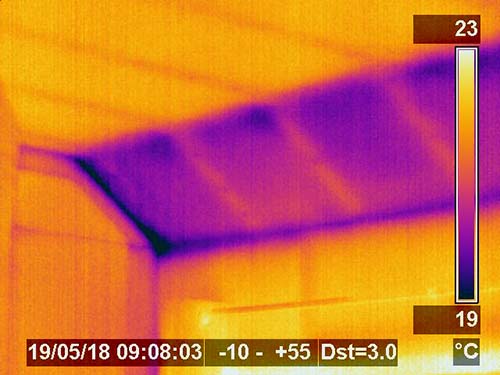Professional Thermography and Infrared Imaging Services
Thermal imaging offers a fast, non-invasive and non-destructive means of monitoring and diagnosing the condition of buildings.
Thermal imaging is a very effective, non-invasive building diagnostic procedure when used professionally.
There are many many applications, and recent restrictions on working at height and ever increasing demands for carbon footprint reduction have increased the demand for this service.
Snughome's inspectors are experts in thermographic imaging and will pinpoint areas of energy loss without disruption to the building structure. Our final report will advise on all aspects of improving the energy efficiency of your home.
Thermal imaging applications and benefits at a glance
- Reduction in uncontrolled heat loss. Can account for 25% or more of a building's heat loss
- Identify structural defects that create thermal bridges. Remove/manage sources of thermal discomfort and condensation problems.
- Check or prove insulation continuity. Avoid another source of heat loss and condensation problems.
- Find hidden leaks, sources of damp in a building or home. Eliminate uncontrolled moisture that can lead to mould and associated health problems.
- Ensure building fabric has dried following flooding/plastering, identify areas that have been contaminated with hygoscopic elements. Avoid storing up trouble by trapping moisture behind new finishes.
- Identify and isolate roof defects. Make effective repairs and avoid expensive early replacement of roof elements.
- Evaluate and verify repair work. Peace of mind for repairers and their customers.
How Thermal Imaging works
The outer skin of any object absorbs thermal energy from its surroundings. A building obtains thermal energy from the sun, atmosphere and human activity. This energy is emitted as thermal radiation, which can be measured by a thermal imaging camera.
Thermal imaging cameras give very accurate temperature measurements across all surfaces. In the context of dwellings, buildings and civil engineering, professionals use thermal imaging to observe temperature variaton patterns. This enables them to identify conditions or events they wish to eliminate, isolate or confirm.
Unfortunately the unaided eye cannot see in the infrared/thermally. Thermal images allow the user to see thermally, revealing anomalies that in turn identify problems in buildings and their component electrical, mechanical, plumbing and waterproofing systems. Snughome.ie's high end market leading thermal/imaging cameras can not only see in real time, but can also record thermal images and measure the temperature of target objects accurately to within 1/10 of a Fahrenheit degree or better.
Points of possible concern show up clearly as hot or cold in relation to their surroundings. Recorded thermal and real time visual images are inserted into reports and can be burnt to cd, greatly facilitating communications amongst the various trades.
Principal Uses for Thermal Imaging
Including but not limited to...
Condition Monitoring
Monitoring equipment and plant on a constant basis to help to highlight likely equipment and plant problems in their infancy.
Learn MoreElectrical Inspections
By far the single most common application for Thermal Imaging worldwide is for electrical inspections.
Learn MoreBuilding Inspections
Thermal imaging is a completely non-destructive method of finding problems within the structure of any building.
Learn MoreQuantitative and Qualitative Inspections
Quantitative inspections are for specific and exact data. With Qualitative inspections, the importance is to get a good clean crisp image
Learn More






